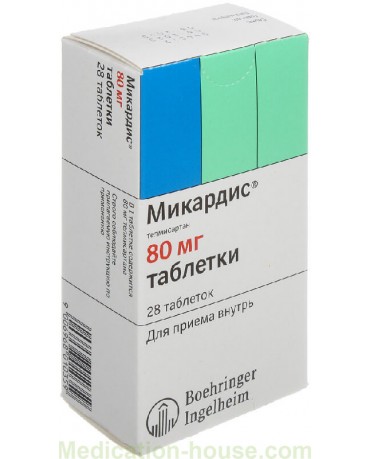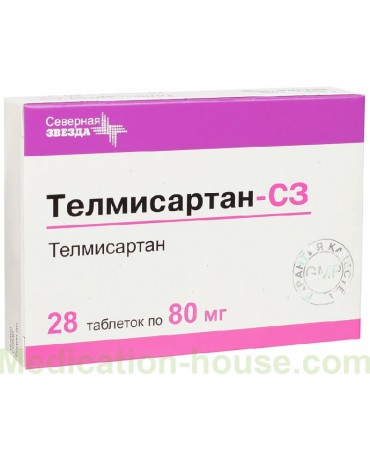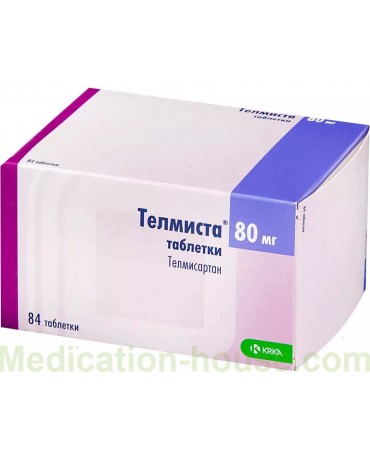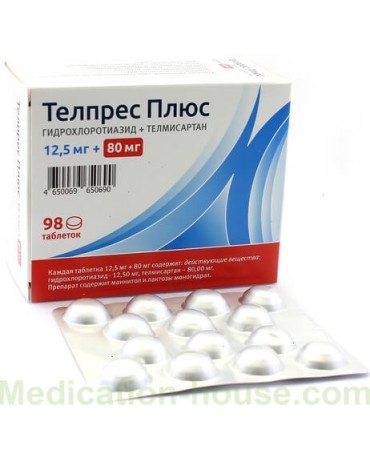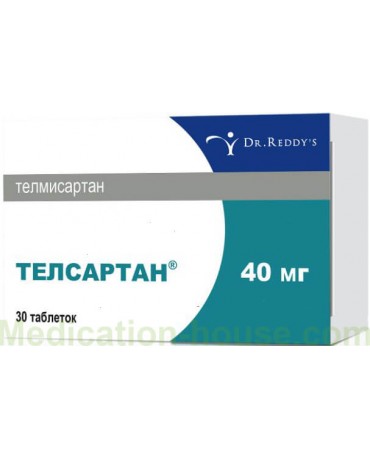Telpres instruction
You can buy Telpres here
Telpres is an angiotensin II receptor antagonist (ARA II), which is highly effective in arterial hypertension (AH).
Release form and composition
Dosage form - tablets: dosage 20 mg - round with a chamfer; dosage 40 and 80 mg - biconvex, oblong; white, engraved with "LC" on one of the sides (in a carton pack 2 or 7 blisters containing 14 tablets each, and Telpres instructions for use).
Composition of 1 tablet:
active substance: telmisartan - 20/40/80 mg;
auxiliary components (for a dosage of 20/40/80 mg, respectively): crospovidone - 3/6/12 mg; magnesium stearate - 2/4/8 mg; mannitol - 81.9 / 163.8 / 327.7 mg; meglumine - 6/12/24 mg; povidone-K25 - 5.4 / 10.8 / 21.6 mg; sodium hydroxide - 1.7 / 3.4 / 6.7 mg.
Pharmacodynamics
Telmisartan is a specific ARA II (type AT1) that is effective when taken orally. It is characterized by a high affinity for the AT1 subtype of angiotensin II receptors, through which the action of angiotensin II is realized. The substance displaces angiotensin II from the connection with the receptor, without having an agonist action with respect to this receptor.
The drug enters into a long-term relationship only with the AT1 subtype of angiotensin II receptors. With other receptors, including AT2 and other less studied angiotensin receptors, the drug does not bind. The functional significance of these receptors, as well as the effect of their likely overstimulation by angiotensin II, the content of which increases during Telpres therapy, has not been studied.
Telmisartan reduces the concentration of aldosterone in the blood, does not block ion channels, does not inhibit plasma renin and angiotensin-converting enzyme (ACE), which also destroys bradykinin. In this regard, an increase in undesirable effects caused by bradykinin is not observed.
The use of tablets at a dose of 80 mg in hypertension blocks the hypertensive effect of angiotensin II in full. After the first intake of the drug, the onset of the antihypertensive effect is observed for 3 hours. Within 24 hours, its therapeutic effect remains and remains significant up to 48 hours. After 28 days after its regular use, a pronounced antihypertensive effect usually develops.
In patients with hypertension, the substance reduces diastolic and systolic blood pressure (BP) without affecting the heart rate. Abrupt discontinuation of the drug is not accompanied by the appearance of a withdrawal syndrome and leads to a gradual return of blood pressure to baseline values.
Pharmacokinetics
The main pharmacokinetic properties of Telmisartan:
absorption: when taken orally, telmisartan is characterized by rapid absorption from the gastrointestinal tract. Its bioavailability is 50%. With concomitant food intake, a decrease in its area under the concentration-time pharmacokinetic curve (AUC) varies from 6% (at a dose of 40 mg) to 19% (at a dose of 160 mg). Regardless of the consumption of food, the content of the drug in the blood plasma levels off after 3 hours after ingestion;
distribution: the substance binds to blood plasma proteins by 99.5%, mostly with alpha-1 glycoprotein and albumin. On average, the indicator of its apparent volume of distribution in equilibrium concentration is 500 liters;
metabolism: telmisartan is metabolized by conjugation with glucuronic acid. Has pharmacologically inactive metabolites;
Excretion: the half-life of the drug substance exceeds 20 hours. In unchanged form, it is practically completely excreted with feces. Renal elimination undergoes less than 2% of the dose taken. It is characterized by a high total plasma clearance (900 ml / min) in comparison with hepatic blood flow (almost 1500 ml / min).
Plasma concentrations of Telpres differ between men and women. Thus, the maximum concentration and AUC in women were 3 and 2 times higher, respectively, compared to those in men. These differences did not have a significant effect on the therapeutic efficacy, and no dosage regimen correction was required.
Since the pharmacokinetics of telmisartan in elderly patients does not differ from that in young patients, no dose adjustment is performed for them. Also, dose changes are not required for mild / moderate renal impairment, whereas in cases of severe renal failure and stay on hemodialysis, it is recommended to start treatment with a lower dose - 20 mg per day. The substance is not excreted during hemodialysis.
The ongoing studies of the pharmacokinetics of the drug in patients with hepatic insufficiency have shown an increase in its absolute bioavailability up to almost 100%. At the same time, its half-life did not change. The daily dose of Telpres for persons with mild / moderate impairment of liver function (on the Child-Pugh scale, class A and B) should not exceed 40 mg.
Indications for use
Telpres is recommended to be taken with hypertension to normalize and maintain blood pressure.
Patients aged 55 years and older with a high probability of cardiovascular pathologies are prescribed the drug to reduce cardiovascular morbidity and mortality.
Contraindications
Absolute:
obstructive diseases of the biliary tract;
severe liver dysfunctions (Child-Pugh class C);
concomitant treatment in combination with aliskiren in patients with impaired renal function (glomerular filtration rate <60 ml / min / 1.73 m2) and / or diabetes mellitus;
combination therapy with ACE inhibitors for diabetic nephropathy;
age under 18;
pregnancy;
lactation period;
established hypersensitivity to the components of the drug.
Relative (taking Telpres tablets requires special care and careful medical supervision):
impaired renal and / or liver function;
stenosis of an artery of a solitary kidney or bilateral stenosis of the renal arteries;
condition after kidney transplantation (due to lack of experience in use);
a decrease in circulating blood volume as a result of previous diuretic treatment, vomiting, diarrhea, or restriction of the use of table salt;
coronary artery disease;
chronic heart failure;
hypertrophic obstructive cardiomyopathy (idiopathic hypertrophic subaortic stenosis);
mitral and aortic valve stenosis;
hyperkalemia;
hyponatremia;
primary aldosteronism (no data on efficacy and safety);
diabetes;
combined appointment with potassium-sparing diuretics, potassium preparations, aliskiren or ACE inhibitors.
Telpres, instructions for use: method and dosage
Telpres tablets are intended for oral administration. Their reception does not depend on the regime and diet.
Recommended dosage regimen:
AH: the initial dose is 40 mg per day. If there is no therapeutic effect, it may be doubled (up to 80 mg per day). It should be taken into account that in most cases the maximum antihypertensive effect of telmisartan is achieved over a period from 28 to 56 days;
reduction of cardiovascular morbidity and mortality: 80 mg per day. It is important to monitor the blood pressure level during the initial period of use, as correction of antihypertensive therapy may be required.
The experience of using Telpres against the background of serious renal dysfunction and hemodialysis is limited. In these cases, the starting dose should be 20 mg per day. Dose for mild / moderate renal impairment is not adjusted.
The daily dose for patients with mild / moderate hepatic impairment (on the Child-Pugh scale, class A and B) should not exceed 40 mg.
No dosage adjustment is required for elderly patients.
Side effects
During treatment with Telpres, the incidence of adverse events is similar to that of the placebo group. The observed cases did not correlate with the race, age or gender of the subjects.
Possible adverse events [> 10% - very common; (> 1% and <10%) - often; (> 0.1% and <1%) - infrequently; (> 0.01% and <0.1%) - rarely; <0.01% - very rare; frequency cannot be set according to the available data - with an unspecified frequency]:
infectious and parasitic pathologies: infrequently - urinary tract infections (including cystitis), upper respiratory tract infections (including sinusitis and pharyngitis); with an unknown frequency - sepsis, including fatal;
blood and lymphatic system: infrequently - anemia; rarely, thrombocytopenia; with an unknown frequency - eosinophilia;
psyche: infrequently - depression; rarely - anxiety;
nervous system: infrequently - vertigo, insomnia; rarely - syncope (fainting);
organ of vision: rarely - visual impairment;
myocardium: infrequently - bradycardia; rarely - tachycardia;
blood vessels: infrequently - orthostatic hypotension, marked decrease in blood pressure (often observed in patients with controlled blood pressure receiving telmisartan therapy to reduce the risk of cardiovascular mortality in addition to standard treatment);
respiratory system, chest and mediastinal organs: infrequently - cough, shortness of breath;
digestive system: infrequently - vomiting, flatulence, dyspepsia, diarrhea, abdominal pain; rarely - liver pathology / liver dysfunction, dryness of the oral mucosa, discomfort, indigestion;
immune system: rarely - angioedema, including fatal, hypersensitivity; with an unknown frequency - anaphylactic reactions;
skin and subcutaneous tissues: infrequently - rash, pruritus, hyperhidrosis; rarely - eczema, toxic skin rash, drug rash, erythema; with an unknown frequency - urticaria;
musculoskeletal system and connective tissue: infrequently - muscle spasms, back pain (for example, sciatica), myalgia; rarely - pain in the limbs, arthralgia; with an unknown frequency - pain in the area of the tendons (tendinitis-like symptoms);
kidneys and urinary tract: infrequently - renal failure, including acute form;
nutrition and metabolism: infrequently - hyperkalemia;
general disorders: infrequently - asthenia (weakness), chest pain; rarely - flu-like condition;
laboratory indicators and instrumental studies: infrequently - an increase in the content of creatinine in the blood; rarely - hypoglycemia (with diabetes mellitus), a decrease in hemoglobin, an increase in the activity of creatine phosphokinase in the blood serum, an increase in the concentration of liver enzymes and uric acid in the blood.
Overdose
Data on Telpres overdose are limited.
The possible most significant symptoms of telmisartan overdose include tachycardia and a marked decrease in blood pressure. Dizziness, acute renal failure, bradycardia, and an increase in serum creatinine may also occur.
Supportive and symptomatic treatment is recommended. Suggested measures include gastric lavage and / or induction of vomiting, the use of activated charcoal, and replenishment of salt and fluid deficiencies. Continuous monitoring of serum creatinine and electrolyte concentrations is recommended. Hemodialysis is not effective.
Special instructions
Due to the fact that telmisartan is mostly excreted in the bile, its use is contraindicated in severe liver dysfunction (according to Child-Pugh class C), biliary obstruction and cholestasis. Presumably, in such patients, the hepatic clearance of the substance is reduced. In case of mild / moderate liver dysfunction (Child-Pugh class A and B), Telpres should be used under medical supervision.
The use of drugs that have an effect on the renin-angiotensin-aldosterone system (RAAS) in patients with bilateral arterial stenosis or arterial stenosis of a single functioning kidney is accompanied by an increased likelihood of severe renal failure and arterial hypotension.
During the period of therapy with Telpres in case of impaired renal function, the concentration of creatinine and potassium in the blood plasma should be periodically monitored. There is no experience of clinical use of the drug in a recent kidney transplantation.
Symptomatic arterial hypotension, especially after taking the first dose, may appear against the background of a reduced circulating blood volume and / or a reduced sodium content in blood plasma due to previous diuretic therapy, restriction of sodium chloride intake, vomiting and diarrhea. Before starting treatment, these conditions (sodium and / or fluid deficiency) must be corrected.
Tablets should not be used in combination with aliskiren for diabetes mellitus or renal failure (glomerular filtration rate <60 ml / min / 1.73 m2); with ACE inhibitors - for diabetic nephropathy.
Double blockade of the RAAS is not recommended (for example, while taking Telpres with other antagonists of this system), since its suppression may lead to the development of such undesirable phenomena as hyperkalemia, syncope, arterial hypotension, impaired renal function, including an acute form of pathology in predisposed patients, especially when combined treatment with several drugs that affect the RAAS.
It should be taken into account that there is a risk of oliguria, hyperazotemia, arterial hypotension and, in rare cases, acute renal failure when using drugs that affect the RAAS in patients with the dependence of renal function and vascular tone on the activity of this system (for example, with chronic heart failure or kidney disease, including bilateral renal artery stenosis or arterial stenosis of a solitary kidney).
Under medical supervision, Telpres, like other vasodilators, should be used against the background of hypertrophic obstructive cardiomyopathy, mitral or aortic stenosis.
In primary aldosteronism, the use of antihypertensive drugs acting by inhibiting the RAAS is usually ineffective.
Treatment with drugs that affect the RAAS is sometimes accompanied by the development of hyperkalemia, which, in the presence of certain conditions / diseases, can lead to death. These include advanced age, renal failure, diabetes mellitus, concomitant pathologies, combined use with drugs that increase the concentration of potassium in the blood plasma.
Prior to the start of the simultaneous use of funds affecting the RAAS, an assessment of the ratio of predicted risks with the expected benefit should be carried out.
Risk factors for hyperkalemia that are important to consider include:
the combined appointment of one or more drugs acting on the RAAS and / or potassium-containing food additives - trimethoprim, immunosuppressants (tacrolimus or cyclosporine), heparin, non-steroidal anti-inflammatory drugs (NSAIDs), including selective inhibitors of cyclooxygenase 2 (COX-2), ARA II, ACE inhibitors, potassium-sparing diuretics, salt substitutes containing potassium;
intercurrent diseases, especially cytolysis syndrome (for example, extensive trauma, rhabdomyolysis, acute limb ischemia), renal impairment, metabolic acidosis, acute heart failure, dehydration;
diabetes mellitus, renal failure, age over 70 years.
In such cases, careful monitoring of plasma potassium is recommended.
Hypothetically, due to a greater predisposition to a decrease in renin activity, in representatives of the Negroid race, ACE inhibitors, telmisartan and other ARA II reduce blood pressure less effectively than in individuals belonging to other races.
An excessive decrease in blood pressure when using Telpres, like other antihypertensive drugs, against the background of coronary heart disease or ischemic cardiomyopathy, sometimes leads to stroke or myocardial infarction.
The appearance of an unexplained fever is an indication for a hematological examination in order to exclude neutropenia, agranulocytosis and leukopenia associated with taking telmisartan.
Influence on the ability to drive vehicles and complex mechanisms
During the period of Telpres therapy, due to the possible development of drowsiness and dizziness, one should drive vehicles, as well as perform other work associated with increased attention, with caution.
Application during pregnancy and lactation
Telpres is contraindicated during pregnancy / lactation.
The use of drugs that directly affect the RAAS can cause serious damage to the developing fetus and lead to its death. Given this, in the planning process or in the case of establishing the fact of pregnancy, the immediate cancellation of telmisartan is important. If necessary, it is allowed to switch to an alternative antihypertensive treatment that has an established safety profile for use during pregnancy.
The teratogenic effect of the drug in preclinical studies has not been established, however, fetotoxicity has been identified. It is known that the effect of ARA II in the II and III trimester of pregnancy causes neonatal toxicity in humans (hyperkalemia, hypotension, renal failure) and fetotoxicity (slowing of cranial ossification, oligohydramnios, decreased renal function).
When planning a pregnancy, it is necessary to transfer the patient to an alternative treatment. If ARA II therapy fell on the II trimester of pregnancy, an ultrasound examination is recommended to check the condition of the skull and kidney function in the fetus.
Newborns whose mothers have taken ARA II should be closely monitored for hypotension.
No studies have been conducted on the effect of telmisartan on human fertility.
Childhood use
The appointment of Telpres to children and adolescents under the age of 18 is contraindicated, since the profile of its safety and efficacy in patients of this age category has not been studied.
With impaired renal function
the appointment of Telpres is contraindicated: impaired renal function (glomerular filtration rate <60 ml / min / 1.73 m2);
application requires medical supervision: impaired renal function, stenosis of the artery of a single kidney, bilateral stenosis of the renal arteries, condition after kidney transplantation.
For violations of liver function
the appointment of Telpres is contraindicated: severe liver dysfunctions (on the Child-Pugh scale, class C);
application requires medical supervision: liver dysfunction.
Use in the elderly
There is no need for dose adjustment for elderly patients.
Drug interactions
Combination therapy of telmisartan with other antihypertensive drugs can lead to an increase in the antihypertensive effect of the latter. There were no additional clinically significant interactions, including when Telpres was used in combination with amlodipine, simvastatin, paracetamol, ibuprofen, glibenclamide, hydrochlorothiazide, warfarin and digoxin.
Patients with diabetic nephropathy should not use telmisartan concomitantly with ACE inhibitors. In case of renal failure (GFR <60 ml / min / 1.73 m2 of body surface area) or diabetes mellitus, Telpres should not be used simultaneously with aliskiren. The appointment of this combination in other cases is not recommended.
According to clinical studies, double blockade of the RAAS due to the combined use of telmisartan and aliskiren, ARA II or ACE inhibitors is associated with a higher incidence of side effects in the form of impaired renal function (including an acute form of the disease), hyperkalemia and arterial hypotension compared with monotherapy. these drugs.
The likelihood of hyperkalemia may increase while taking Telpres with other drugs that can cause this pathological condition, namely salt substitutes containing potassium, potassium-containing food supplements, NSAIDs (including selective COX-2 inhibitors), heparin, potassium-sparing diuretics (amiloride , triamterene, eplerenone, spironolactone), immunosuppressants (trimethoprim, tacrolimus, cyclosporine). In cases of documented hypokalemia, if necessary, a combined appointment of these drugs is allowed under close medical supervision and regular monitoring of the potassium content in the blood plasma.
Against the background of the simultaneous administration of the drug with digoxin, an increase in the average maximum and minimum plasma concentration of the second drug was noted by 49% and 20%, respectively. At the beginning of therapy, when selecting dosages and carrying out the withdrawal of telmisartan, it is important to carefully monitor the level of digoxin in the blood plasma to maintain it within the therapeutic range.
Telpres, like other ARA IIs, reduces the loss of potassium caused by diuretics. Salt substitutes, potassium supplements, and potassium-sparing diuretics (such as amiloride, triamterene, eplerenone, or spironolactone) can significantly increase plasma potassium. If complex treatment is indicated (with documented hypokalemia), it is important to exercise caution and regularly monitor plasma potassium.
ACE inhibitors and ARAII, including telmisartan, cause a reversible increase in the content of lithium in the blood plasma and its toxic effect when used concomitantly with drugs containing the element. It is recommended to carefully monitor the concentration of lithium in the blood plasma for the period of complex therapy.
NSAIDs (including non-selective, COX-2 inhibitors and acetylsalicylic acid in doses prescribed for anti-inflammatory treatment) can weaken the antihypertensive effect of ARAII. In some patients with impaired renal function (for example, patients with dehydration and the elderly), the combination of ARAII with drugs that inhibit COX-2 may contribute to further deterioration of renal function, including the appearance of acute renal failure, which is usually reversible ... In connection with the above, such a combination of drugs should be prescribed with caution, especially in elderly patients. Their treatment should be carried out under regular monitoring of renal function indicators at the beginning of therapy, periodically in the future and accompanied by ensuring the flow of a sufficient amount of fluid into the body.
It is possible that hypovolemia and the risk of arterial hypotension may appear at the beginning of Telpres' administration in patients who received previous treatment with high-dose diuretics, such as hydrochlorothiazide and furosemide (thiazide and loop diuretic).
Strengthening the effect of Telpres can be noted with concomitant use with other antihypertensive drugs. Based on the pharmacological properties of amifostine and baclofen, it can be assumed that they will potentiate the action of all antihypertensive drugs, including Telpres. Increased orthostatic hypotension is also possible with the simultaneous use of alcohol, antidepressants, drugs or barbiturates.
The action of telmisartan is weakened by corticosteroids for systemic use.
Terms and conditions of storage
Store in a place protected from light and moisture at temperatures up to 25 ° C. Keep out of the reach of children.
Shelf life is 2 years.
Reviews
Patients leave mostly positive reviews about Telpres. The advantages most often include the budgetary cost of the drug, its high efficiency in reducing blood pressure and a stable result.
In one case, during therapy with a drug, a patient developed negative side reactions in the form of back pain and depression.
Terms of sell
You don't need a prescription to buy Telpres.


